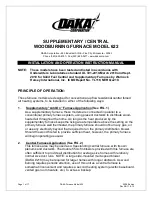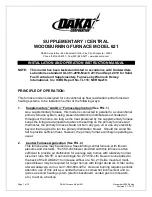
035-17473-000-B-1101
Unitary Products Group
5
NON-SUSPENDED INSTALLATION
Maintain clearances to combustibles as outlined in
Table 1. Installation on a combustible floor requires a
clearance of 1 inch. This can be done by using non-
combustible materials such as one inch thick channel
iron or similar material. The furnace must be supported
in such a way as to not allow twisting or sagging of the
cabinet. Suggestion; as a measure to prevent fuel oil
from accumulating in locations other than the fire pot,
as could be the case in the event of nozzle drip, install
the furnace with an approximate 2 degree slope from
the oil burner casing towards the fire pot. Use shims
made of noncombustible material.
SUSPENDED INSTALLATION
Refer to Figure 1. Maintain clearances to combustibles
as outlined in Table 1. Remove the four circular knock-
outs on the top panel, and similarly, the four circular
knock-outs on the bottom panel. The removed knock-
outs allow 3/8 inch treaded road to be inserted through
the interior of the furnace. Use care when inserting
rods, since the foil backed insulation can be easily
ripped and torn away from the panel surfaces. Secure
the furnace with 2 inch minimum slotted angle or equiv-
alent, as shown in Figure 4. The furnace must be sup-
ported in such a way as to not allow twisting or sagging
of the cabinet. Suggestion; as a measure to prevent
fuel oil from accumulating in locations other than the
fire pot, as could be the case in the event of nozzle
drip, install the furnace with an approximate 2 degree
slope from the oil burner casing towards the fire pot.
AIR CONDITIONING APPLICATIONS
If the furnace is used in conjunction with air condition-
ing, the furnace shall be installed in parallel with or with
the evaporator coil upstream from the furnace to avoid
condensation in the heat exchanger. In a parallel instal-
lation, the dampers or air controlling means must pre-
vent chilled air from entering the furnace. If the
dampers are manually operated, there must be a
means of control to prevent the operation of either sys-
tem unless the dampers are in the full heat or full cool
position. The air heated by the furnace shall not pass
through a refrigeration unit unless the unit is specifi-
cally approved for such service.
The blower speed must be checked and adjusted to
compensate for the pressure drop caused by the evap-
orator coil. Refer to Appendix B for recommended wir-
ing and electrical connections of the air conditioning
controls.
COMBUSTION AIR
If the furnace is installed in a closet or utility room, two
ventilation openings must be provided connecting to a
well ventilated space (full basement, living room or
other room opening thereto, but not a bedroom or bath-
room). One opening shall be located 6” from the top
and bottom of the enclosure at the front of the furnace.
Each opening shall have a minimum free area of 1½
square inches per 1,000 Btu/h of total input rating of all
appliances installed in the room.
For furnaces located in buildings of unusually tight con-
struction, such as those with high quality weather strip-
ping, caulking, windows and doors, or storm sashed
windows, or where basement windows are well sealed,
a permanent opening communicating with a well venti-
lated attic or with the outdoors shall be provided, using
a duct if necessary. The duct opening shall have a free
area of 1½ square inches per 1,000 Btu/h of total input
rating of all appliances to be installed. When a furnace
is installed in a full basement, infiltration is normally
adequate to provide air for combustion and draft opera-
tion. Furnace rooms under 65m³ (700 ft³) should auto-
matically be treated as confined space.
The Model CAS-2B-90E Furnace Boot manufactured
by Field Controls, Inc. may be used with the furnace to
obtain combustion air directly from outdoors. Use of
this device does not alter the need for ventilation air;
however, it does provide a good direct source of com-
bustion air and is connected directly to the oil burner.
CHIMNEY VENTING
The chimney must be sized correctly and be in good
repair. If the chimney is oversized, there is a high risk of
the flue gases condensing resulting in damage to the
chimney and other venting parts. This problem may be
corrected by the use of an appropriately sized chimney
liner.
If the chimney serves the furnace only, the vent should
be sized at 4 inch minimum, 5 inch maximum. If the fur-
nace is to be co-vented with other appliances, refer to
CAN/CSA B139, Installation Code For Oil Burning
Equipment or NFPA 211, Standard for Chimneys, Fire-
places, Vents, and Solid Fuel-Burning Appliances for
correct sizing information.






































